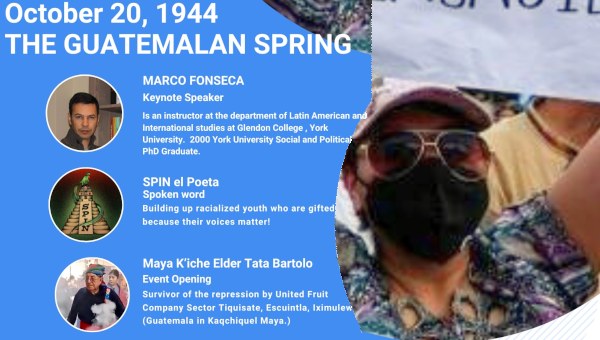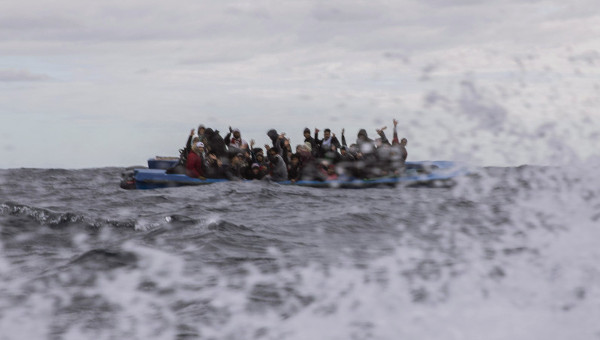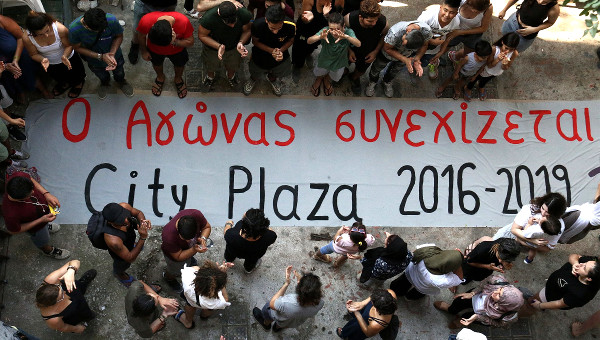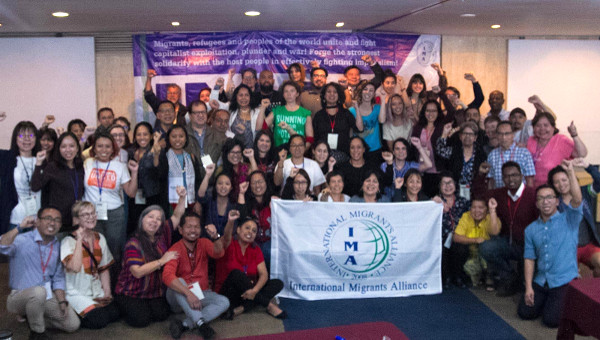Migrant Caravans Challenge the Continent’s Governments
Central American migrants, both desperate and courageous, have thrust themselves into the center of Mexican and U.S. politics with their demand for refuge and asylum. As the head of the NGO Pueblos Sin Fronteras told a reporter, “This isn’t just a caravan, it’s an exodus created by hunger and death.”
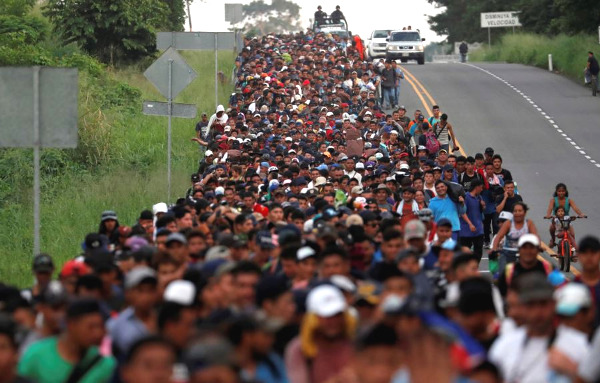 The thousands of migrants organized in caravans and walking north from Central America, through Mexico, and to the United States – some 3,000 miles – have raised a challenge to the governments and to the people of North America. Driven by poverty and violence, their long march is an implicit critique of the Central American governments that have failed to protect them and have made it impossible for them to earn a living. At the same time, it is in its very form a denunciation of Mexico, since they must travel in caravans because of the violence that migrants face in Mexico from both criminals and the corrupt police. And when the caravan reaches the border, it will be a challenge to the United States to adhere to its laws and international agreements that allow migrants to present petitions for refugee or asylum status.
The thousands of migrants organized in caravans and walking north from Central America, through Mexico, and to the United States – some 3,000 miles – have raised a challenge to the governments and to the people of North America. Driven by poverty and violence, their long march is an implicit critique of the Central American governments that have failed to protect them and have made it impossible for them to earn a living. At the same time, it is in its very form a denunciation of Mexico, since they must travel in caravans because of the violence that migrants face in Mexico from both criminals and the corrupt police. And when the caravan reaches the border, it will be a challenge to the United States to adhere to its laws and international agreements that allow migrants to present petitions for refugee or asylum status.
Beyond all that however, the simple act of walking north is a courageous and defiant act of resistance against the economic and political system that envelopes North America, with its ‘free markets’, its authoritarian governments, and its failure to meet the basic human needs of millions. The migrants have put contemporary capitalism and imperialism on trial.
Escaping Poverty and Injustice
The migrants – men, women, and children – formed the caravans in late October. Migrants have for years traveled in groups because of the danger in both Central America and Mexico of being beaten, robbed, raped, kidnapped, or murdered by either criminals or police, but these caravans of thousands represent a new development. Usually migrants pay thousands of dollars to smugglers known as coyotes or polleros who arrange to take them across the Mexican and U.S. borders. These new migrant caravans, however, at first simply forced their way across the Mexican border, overwhelming border police, or crossed the Suchiate River. They have compelled the Mexican government to permit them to enter the country.
In Mexico, migrants have been supported by local governments, the Catholic Church, and NGOs such as Pueblos Sin Fronteras (Peoples Without Borders), which have helped to provide them with water and food and also aided in choosing the best routes and campsites. The NGOs have also helped with the many who have become exhausted, gotten sick, or been injured. Irineo Mújica, the director of Pueblos Sin Fronteras, reported that Mexican police had roughed up both men and women in the caravan. “Never in the history of the caravans have we seen such violence. I understand that the Mexican government is desperate, but violence is not the solution,” said Mújica. At times groups have broken off from the caravan to find their own way or to take advantage of passing flat bed trucks, riding, crowded on the trailers. There are reports that as the caravan moved along some 100 migrants have gone missing and some believe they have been kidnapped by the criminal cartels.
As the migrants come, Mexico’s in-coming President Andrés Manuel López Obrador, who will take office on Dec. 1, proposed an international development program for Central America to get to the root of the issues that cause the migration problem, and promised that his planned public works programs would create 400,000 jobs for Mexicans and immigrants. Speaking in late October, he said, we will have jobs for all, for both Mexicans and Central Americans. Faced with the migrants challenge and under pressure from U.S. President Donald Trump, out-going Mexican President Enrique Peña Nieto (EPN) offered the migrants a program called, “Estás en tu casa” or “You are at home,” that would provide asylum, work permits, identification cards, medical care, and schooling. At the same time, he made that plan contingent upon the migrants remaining in the southern Mexican states of Chiapas and Oaxaca. The caravan held meetings to discuss EPN’s offer, which was rejected by the group as a whole. Most wanted to continue on. As one man said, “These states are overwhelmed by poverty, in Mexico the jobs are up north.” Hundreds, however, accepted the Mexican offer and dropped out of the caravan.
At this moment, two caravans, several thousand migrants altogether, have now reached Mexico City where the Mexican government has offered them shelter in the Jesús Martínez “Palillo” stadium. Portable toilets have been set up, but they haven’t been adequate for the numbers of people and visitors, creating unsanitary conditions. Edgar Corzo Sosa of the National Human Rights Commission (CNDH) says that, “Pregnant woman, and above all, the newborns, are the most vulnerable group. There is no census, it’s complicated, but a third of the caravan is made up of children, and there are altogether about 5,000 people”
President Donald Trump, campaigning feverishly, attending 17 election rallies, principally to support Senate candidates in the midterm elections, made the caravan the center of his campaign. He called the caravan an “invasion,” asserted that the migrants were members of Mara Salvatrucha or MS-13, “hardened criminals” and he claimed that there were “Middle Easterners” – read terrorists – among them. Trump threatened to send 15,000 U.S. troops to the border and said that U.S. soldiers could fire on migrants if they threw stones. He has threatened to cut off aid to the Central American nations from which the caravans have come and the American president also raised the idea of using his executive power to end constitutional birthright citizenship in the United States.
What Caused the Caravan Crisis?
American imperialism is at the root of the current migration crisis. The story of the United States in Central America is a long one going back to the nineteen century, but the most recent chapter begins in 1981 when U.S. President Ronald Reagan supported right-wing governments in Guatemala and El Salvador while also fighting against a popular revolution in Nicaragua. U.S. weapons poured into those countries during the civil wars there that lasted until the 1990s. Those wars took hundreds of thousands of lives and left parts of those countries in ruins.
Peace in these Central American nations was negotiated in the mid-1990s, just as the United States and the Central Americans governments were negotiating the Central American Free Trade Agreement (CAFTA), a treaty that opened their economies to foreign competition. The treaty devastated local industries and agriculture, leading to vast unemployment. Farmers lost their farms; factories threw workers out on the street.
More than a decade and a half of war had flooded the region with heavy weapons and the disbanding of the various armies left thousands with no means of employment. The United States government set up a chain of drug dealing operations that were used to fund the Contra War against Nicaragua and those continued after the war ended. In the 1980s, the United States also began to deport Central American gang members in groups like the MS-13 and M-18. Many of these men and women had had no contact with the countries to which they were being deported, and once back in Central America they established branches of the gangs they had belonged to in the United States. This toxic mix of groups trained in violence, easily available heavy weapons and criminal drug activity has made the “northern triangle” Central American countries of Honduras, El Salvador and Guatemala some of the most violent countries with the highest murder rates in the world.
The most recent imperialist intervention in Central America occurred when former President Barack Obama and his then Secretary of State Hillary Clinton sponsored a military coup in Honduras against the democratically elected leftist president Manuel Zelaya. Since then, the antidemocratic government of President Juan Orlando Hernández has instituted a neoliberal model that has deepened the economic dependence on the United States and worsened living conditions for millions of Hondurans. Hernández has also criminalized the organizers of the caravan who have attempted to respond to the humanitarian crisis that so many Hondurans have been living.
Today, a new ruling elite dominates Central America. As Aaron Schneider and Rafael R. Ioris wrote in NACLA, after the extraordinary violence in the Honduran election of 2017, there has been “a growing consolidation of power by a new kind of right-wing alliance in Honduras and across Latin America: an alliance that brings together the power of the traditional landed elites and that of the financial elites who have benefited more recently from globalized neoliberalism. This alliance emerged amid the ashes of the Cold War and the dawn of the Washington Consensus…”
Today, Poverty and Violence
Poverty has been and remains endemic in most of Central America where about one-third of the population lives in extreme poverty. Extreme poverty is defined by the United Nations as “a condition characterized by severe deprivation of basic human needs, including food, safe drinking water, sanitation facilities, health, shelter, education and information.” The World Bank recently put this in economic terms, describing those in extreme poverty as earning less than $1.90 per day.
As the International Labour Organization wrote a year ago, “Over 50 million young people in Latin America and the Caribbean face a labour market characterized by unemployment, informality and a lack of opportunities.” About half the people in Latin America work in the informal economy – in Central America the rate is between 40 and 80 per cent – that is to say people work for employers who often ignore labour laws and provide no benefits, or people are self employed in micro-businesses or as peddlers. The lack of jobs and decent pay, mean a life of poor housing and bad health, while families face insecurity and children are put at great risk of malnutrition that can affect both their physical and mental development.
Climate change is also playing a role in the Central American migration. According to Scientific American, a drought this year deprived some 2.8 million people in the region of their food. The drought has affected the so-called “dry corridor” of Central America, that runs through southern Guatemala, northern Honduras and western El Salvador. Olman Funez, a young farmer from Orocuina in southern Hunduras said, “The drought has killed us. We lost all our corn and beans.”
The choices made in Washington and New York, decisions to promote so called “free markets” or to continue to permits the expansion of carbon fuels such as coal and petroleum, have brought misery to Central America, exacerbating poverty and setting people in motion, moving out and moving north, going to where they can find jobs.
Violence in the Central American nations is also a way of life, and it has been increasing recently. Guatemala has been violent for years, but the terror has increased recently. While anyone might be murdered at almost any time, peasant and worker activists are often the victims of violence. Between May 9 and June 8, seven leaders of peasant organizations were murdered in Guatemala.
As Simon Granovsky-Larsen writes in NACLA, “Data collected by human rights organizations over the years show a relatively consistent pattern: outside of police or military shootings at protests, one rights defender has been killed in Guatemala every month or two all the way back to 2000. The campesino murders of 2018 obliterate any predictability with shocking violence. Guatemala has not seen anything like this since the official end of its armed conflict in 1996.” The violence against peasant leaders is intended not only to stop their labour organizing, but also to deter peasants from politically challenging the government.
A popular democratic rebellion against Daniel Ortega’s authoritarian regime in Nicaragua was violently suppressed by his government with arrests, torture, and hundreds of deaths, led tens of thousands of Nicaraguans to flee to neighboring Costa Rica. Political violence in some states has combined with the criminal violence found throughout the region creating an expanding blood bath. Survivors of the slaughter have joined the migration through Mexico toward the United States to escape the misery and violence that enveloped them.
The Challenge Facing the Caravan in the United States
The migrant caravans may face its greatest challenge at the U.S.-Mexico border when migrants attempt to present their applications for refugee or asylum status. The immigrants must present their application for asylum to an immigration judge, which means they must be given an immigration hearing. Economic refugees, those who come simply because they want to work and earn a living are not eligible for refugee or asylum status. The U.S. law defines refugees or those seeking asylum as “a person who is unable or unwilling to return to his or her country of nationality because of persecution or a well-founded fear of persecution on account of race, religion, nationality, membership in a particular social group, or political opinion.”
The United States today offers hope to few refugees. Under President George H.W. Bush the government accepted between 125,000 and 142,000 refugees. In the 2000s, George W. Bush and Obama years, the United States admitted about 80,000 people each year. However, under the Refugee Act of 1980, the president has the responsibility, in consultation with Congress, to set a maximum number of refugees who will be admitted to the United States each fiscal year. This year only about 22,000 refugees have been admitted. Trump has said that that number will now be 30,000 for 2019.
Trump has declared that, “The United States will not be a migrant camp and it will not be a refugee holding facility.” He has threatened to close the U.S. southern border altogether, though for economic reasons though he seems unlikely to do so. Trump’s Homeland Security used the U.S. Border Patrol to “systemically deny entry to asylum seekers,” according to an immigration rights group. The Trump administration’s policy is that all adults crossing the border without inspection or without immigration documents are to be arrested. When they are arrested children are now routinely separated from their parents, as thousands have been, among them hundreds of small children. Trump’s most recent step week, based on national security from threats coming from abroad, has been to order that any migrant who crosses the border illegally be denied asylum. Civil rights groups argue that many of Trump immigration policies are illegal and they are challenging them in court.
The U.S. border is now largely militarized, with thousands of Border Patrol agents backed up by the National Guard and now some U.S. Army troops. Except along the Rio Grande River, there is a nearly continuous border wall between the United States and Mexico. It is possible to climb the wall or cross through the gaps, though cameras and radar monitor the area, and many who attempt to cross are captured, though hundreds also die in the desert every year. Thousands make it to the other side, to a life in the legal shadows, constantly under the threat of arrest and deportation.
The caravan, nevertheless, moves on, now heading into the dangerous arid regions of northern Mexico dominated by drug cartels and the corrupt police who work with them. Meanwhile, throughout the United States groups of humanitarians – religious and political – have been organizing to go to the border, to greet the migrants and to show solidarity with the migrants. They will be protesting government policies and attempting to welcome those who come as refugees and asylum-seekers.
Migration as Class Struggle
This caravan is not the first and will not be the last. As Laura Weiss wrote recently, “The use of caravans as an activism – and survival – strategy was popularized in Central America. Since 2008 Central American mothers whose children disappeared while crossing through Mexico have carried out an annual caravan through Mexico to create awareness about their struggles. In 2012, the poet Javier Sicilia and the Movimiento Por La Paz con Dignidad y Justicia (the Movement for Peace with Dignity or MPJD) ran a caravan through Mexico and into the United States to draw attention to drug war violence after his son was killed, and a number of similar caravans zooming in on drug war violence and abuses followed in later years.” Caravans in Mexico go back decades: caravans of peasants, of teachers, of miners. They are versions of the religious peregrinations that form part of Central American and Mexican culture: people walking in their faith. Walking to where the Virgin once visited the earth, to where the saint helped the poor and downtrodden. Walking with God.
We do not usually think of walking as a form of rebellion or class struggle, but it often surely is. The caravan has been called an exodus, like the exodus of the Jews from slavery in Egypt. Black people in slavery in the United States took up the story of exodus, seeing themselves like the Jews of Egypt, living in slavery, dreaming of freedom, and they sang in their famous hymn, “Let my people go!” Today the migrants are engaged in their exodus, walking toward freedom, though they are finding that Pharaoh is not only in Egypt, not only in Central America, but also in Mexico and in the United States. Still the caravan moves on, holding the migrants in the embrace of hope, inspiring them to struggle, inspiring us to stand in solidarity with them. We are, after all, all of us, implicated in this caravan, in this walk toward freedom. •
This article first published on the International Viewpoint website.


